You are currently browsing jmfr’s articles.
“The Soul Seeks Its Melodies”: Music in Jewish Thought. Dov Schwartz. Translated by Batya Stein. Brookline, MA: Academic Studies Press. 2022.
Reviewed by Aubrey L. Glazer
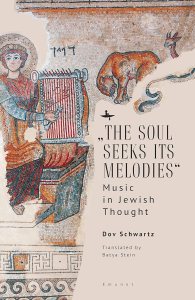
When we listen deeply to music, we realize the truth that “[e]very musical phenomenon points to something beyond itself by reminding us of something, contrasting itself with something or arousing our expectations.” [1] Such a reflection from German Jewish philosopher and pianist Theodor Adorno’s prolific musical thinking appears in a 1963 essay collected in the book Quasi Una Fantasia. Adorno was a prolific Jewish thinker who spent a lifetime reflecting on how music is itself a thought process by which content is defined “not because its particular elements express something symbolically” but through a paradoxical process of “distancing itself from language that its resemblance to language finds it fulfillment.” [2] To enter into the realm of analyzing music in Jewish thought, one would therefore expect these kinds of approaches to musical thinking to be engaged as a starting point. It is striking, then, to suggest that music can be a power to “communicate without words,” as Dov Schwartz concludes in his recent book “The Soul Seeks Its Melodies”: Music in Jewish Thought, writing that this is “one of the deepest meanings of music as a language” (299). The contrast between these distinct approaches to musical thinking and its language in Adorno and Schwartz would have been a natural starting point to fill an entire book. However, Adorno’s absence from this monograph reveals much about the foundations of Dov Schwartz’s philosophical approach.
Read the rest of this entry »The Oxford Handbook of Jewish Music Studies. Edited by Tina Frühauf. Oxford and New York: Oxford University Press. 2023.
Reviewed by Paul G. Feller-Simmons
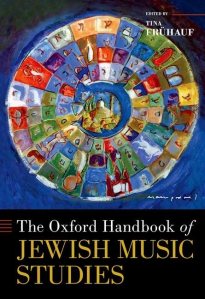
The publication of The Oxford Handbook of Jewish Music Studies, edited by Tina Frühauf, marks a much-anticipated milestone. Released in November of 2023, the weighty tome attests to the rapidly changing landscape of the field, offering a comprehensive exploration of manifold subjects. With twenty-nine chapters plus an introduction penned by scholars at various stages of their careers, the Handbook truly mirrors the best facets of the field’s current state. While it would be a daunting task to do justice to every chapter within the confines of this review, particularly for an avowed early modernist such as myself, it suffices to say that the volume exudes scholarly rigor and innovation.
Read the rest of this entry »City of Song: Music and the Making of Modern Jerusalem. Michael A. Figueroa. Oxford: Oxford University Press. 2022.
Reviewed by Tanya Sermer
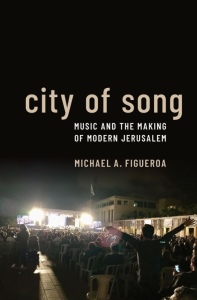
Michael A. Figueroa’s captivating City of Song: Music and the Making of Modern Jerusalem is a book about Jerusalems—high/low, celestial/terrestrial, metaphorical/material—and how musical representations of the city have produced a multiplicity of political imaginaries about those Jerusalems in modernity. Combining an impressive array of interdisciplinary theory, historical and archival study, ethnographic fieldwork, and close listening to songs in Hebrew about the city, Figueroa creates a sophisticated framework for understanding how music and poetry (from the Psalms through Israeli popular song of the 1970s) have been used to create subjective and changing “spatial knowledge” about Jerusalem among Zionist Jews and Israelis over the course of the twentieth century. Presenting a remarkably nuanced exploration of the contested meanings inherent in cultural output regarding the city, Figueroa is deliberate in his relational approach to the people and spaces in his study; discussions of Jerusalem throughout the book consider the perspectives and concerns of Palestinian Arabs, Armenians, or ethnic and religious divisions within the Jewish and Israeli populations. Figueroa’s commitment to a relational approach—a growing body of such scholarship in musical studies of Israel and Palestine that aims to break down the mutual exclusion of those two national narratives as well as the conventional dichotomies within them—offers the reader a rich picture of the social and political forces at play and the greater implications of the territorial imaginaries that underpin the songs Figueroa examines.
Read the rest of this entry »Encyclopaedia of British Jewish Cantors, Chazanim, Ministers and Synagogue Musicians: Their History and Culture. Michael Jolles. London: Jolles Publications. 2021.
Reviewed by Judith S. Pinnolis
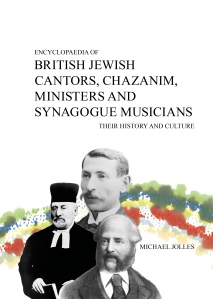
Without question, this monumental work of nearly 900 pages (and growing) is a vast achievement and watershed moment in the history of Jewish music in the United Kingdom. The volume gathers and documents a vast historical record in a single compendium. Historian Michael Jolles has created an unparalleled resource available to anyone with an internet connection. While supported by an editorial board, the work displays the views and perspective of a single individual, which Jolles has dubbed a “framework” for the study of British chazanim (the religious prayer leader), synagogue musicians, and institutions. The work also includes lists of rabbis, composers and others contributing to synagogue music. The detailed facts and figures collected represent an amalgamation from myriad archival and research resources into an organized collection. The volume is organized in two main parts. The first describes the roles of the various musicians of the synagogue and the attending historical and cultural backgrounds, which serve as introductory materials, and the second consists of a collection of biographical sketches of various lengths and depths, which date from names known as early as 1656 up to the present.
Read the rest of this entry »Between Tradition and Modernity: The High Holy Days Melodies of Minhag Ashkenaz According to Ḥazzan Maier Levi of Esslingen. Geoffrey Goldberg. Jerusalem: Jewish Music Research Centre – Hebrew University of Jerusalem. 2019.
Reviewed by Marsha Bryan Edelman
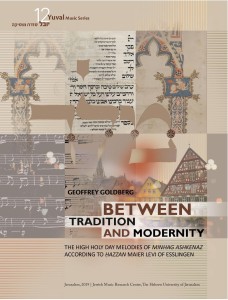
Ethnomusicologist Abraham Zvi Idelsohn (1882-1938) put the study of Jewish music on the scholarly map with the publication of his 10-volume Thesaurus of Hebrew Oriental Melodies (Leipzig: Breitkopf & Härtel et al., 1914–32). Long considered an authoritative resource, Idelsohn’s work has come under some scrutiny by more recent research and by the discovery of additional materials that complement, and occasionally contradict, Idelsohn’s conclusions. The Yuval Music Series, launched by the Jewish Music Research Centre at the Hebrew University of Jerusalem in 1989, has endeavored to provide a sequel to Idelsohn’s research. Geoffrey Goldberg’s Between Tradition and Modernity: The High Holy Day Melodies of Minhag Ashkenaz according to Hazzan Maier Levi of Esslingen is Volume 12 in the Yuval Series, and a most worthy contribution.
Maier Levi (1813 – 1874) is not a well-known name in the history of cantorial music, nor was Esslingen a major center of Jewish life. What makes the present work so valuable is that Levi served as a teacher of hazzanut and prepared his compendium as a study tool for his students at the Esslingen Teachers Seminary from which Levi had also graduated, although at the time, training in hazzanut was very limited; Levi enhanced his own cantorial knowledge through private study with other local hazzanim. In addition to providing details about Levi’s life and career, Goldberg also recounts the history of the types of training available to nineteenth-century hazzanim in Germany (only some of which Levi himself experienced). The key takeaway from this historical background is that Levi lived and taught at a pivotal moment brought about through the Emancipation of German Jewry (1848) and the aesthetic revisionism of the emerging Reform movement (1819). His compendium, completed over the course of many years (1845-late 1860s) thus reflects the changing musical styles Levi and his students would have experienced, and his notations reflect the evolution from “old-world,” often highly embellished tunes, to the more “modern” and unadorned chants in vogue during his later years.
Read the rest of this entry »“Ya Shema Evoynecha,” performed by Carla Berg, original poem in Hebrew by Yehuda Halevi, Ladino lyrics by Rabbi Reuven Eliyahu Yisrael, uploaded September 15, 2022, https://www.youtube.com/watch?v=v2QlJLkgeZw.
Reviewed by Lealiza Lee
The piyyut “Ya Shema Evoyonecha,” by Yehuda Halevi, is most widely known as a component of the Sephardic selichot service. Carla Berg is a vocalist who brings to light a long-forgotten Ladino version of the piyyut in a recording released for Rosh-Hashana.
Read the rest of this entry »Recording History: Jews, Muslims, and Music across Twentieth-Century North Africa. Christopher Silver. Stanford, CA: Stanford University Press. 2022.
Reviewed by Hugo Hadji
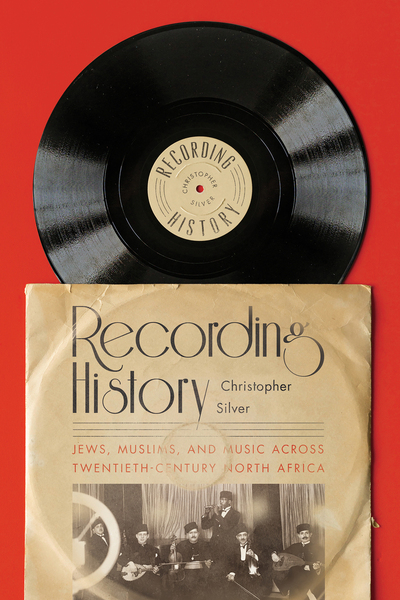
In Recording History: Jews, Muslims, and Music across Twentieth-Century North Africa, Christopher Silver provides the first in-depth and comprehensive history of the North African music recording industry and scene from the dawn of the twentieth century to the early post-independence era. Guided by the premise that music and history are mutually constitutive, Silver offers to listen to the sounds and artists that shaped and reflected the identities of Jews and Muslims living in the Maghreb region during that period. Such work, Silver convincingly argues, “provides twentieth-century North Africa with a soundscape that dramatically alters its historiographical landscape” (13) and allows us to use music to explore Jewish-Muslim relationships, coexistence, and subjectivities outside of and challenging the typical frameworks of “majority-minority” power relations and the mass departure of Jews in the 1950s and 1960s dominant in the literature. It further allows us to acknowledge and recount the central place Jews held in the construction and development of the recording industry and popular musical scene in North Africa, as artists and as intermediaries.
Read the rest of this entry »Jerusalem: Blake, Parry, and the Fight for Englishness. Jason Whittaker. Oxford, UK: Oxford University Press. 2022.
Reviewed by Benjamin Wolf
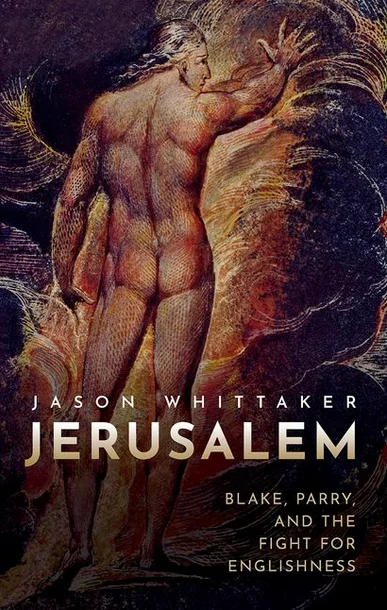
This is a book about a single poem and a single song: William Blake’s poem, Jerusalem (“And did those feet in ancient time walk upon England’s mountains green”), and Hubert Parry’s famous setting of it. This combination of words and music has been central to British (perhaps it is better to say English) cultural life since Parry’s composition was first performed in 1916. Although originally composed for “Fight for Right,” an organization that supported Britain’s war efforts, it was subsequently adopted by the women’s suffrage movement, the Women’s Institute, and by figures on both the left and right of the political spectrum. Jason Whittaker traces this history, and the possible cultural meanings of both Blake’s poem and Parry’s setting of it, over a two-hundred-year period, ending in the Britain of the 2011 royal wedding, the 2012 Olympic Games and the 2016 Brexit referendum. Where British musical history is concerned, this book takes a valuable place alongside others such as Andrew Blake’s The Land without Music or Hughes and Stradling’s more cynical The English Musical Renaissance 1840 – 1940. [1]
Read the rest of this entry »Sonic Ruins of Modernity: Judeo-Spanish Folksongs Today. Edwin Seroussi. London: Routledge. 2023.
Reviewed by Lori Sen
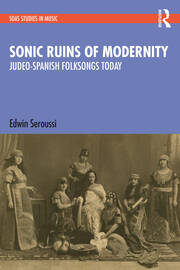
A minority within the Jewish people, Sephardim are a triple diasporic population, who carried with them their culture, traditions, language (Judeo-Spanish), and oral literature. Judeo-Spanish folksongs are among the Sephardim’s oral literature and reflect the diverse influences of the many cultures they encountered throughout their five-hundred-year-long journey from medieval Iberia to all over the modern world. With Sonic Ruins of Modernity, musicologist Edwin Seroussi introduces the contemporary concept of folksong (in the post-tradition era) as a sonic ruin, regularly visited by tourists interested in exploring the history of other cultures.
Read the rest of this entry »A Jewish Voice from Ottoman Salonica: The Ladino Memoir of Sa’adi Besalel a-Levi. Edited and with an Introduction by Aron Rodrigue and Sarah Abrevaya Stein. Translation, Transliteration, and Glossary by Isaac Jerusalmi. Stanford, CA: Stanford University Press, 2012. ISBN 978-0-8047-7166-5
Reviewed for Musica Judaica Online Reviews by Kathleen Wiens
A Jewish Voice from Ottoman Salonica presents the personal diary of Sa’adi Besalel a-Levi (1820-1903) in English translation and Ladino transliteration from the original in soletreo (Hebrew script of Ottoman Ladino dialect). Penned starting in 1881, the autobiographical account incorporates event descriptions and commentary on Jewish community life in Salonica (now Thessaloniki, Greece). Sa’adi’s motivations for writing his memoirs included a desire to record customs and events for future generations, and to voice his personal concerns and hopes for Jewish life in Salonica. Sa’adi’s primary occupations were as an editor and print-maker, but he was also respected within the Jewish community and city as a singer and composer of songs for synagogue and special occasions. It is this second occupation that makes A Jewish Voice a valuable resource for readers with interest in music and Jewish life.
Ladino transliteration from the original in soletreo (Hebrew script of Ottoman Ladino dialect). Penned starting in 1881, the autobiographical account incorporates event descriptions and commentary on Jewish community life in Salonica (now Thessaloniki, Greece). Sa’adi’s motivations for writing his memoirs included a desire to record customs and events for future generations, and to voice his personal concerns and hopes for Jewish life in Salonica. Sa’adi’s primary occupations were as an editor and print-maker, but he was also respected within the Jewish community and city as a singer and composer of songs for synagogue and special occasions. It is this second occupation that makes A Jewish Voice a valuable resource for readers with interest in music and Jewish life.
A Jewish Voice is divided into three main parts: a 47-page Editors’ Introduction, the English translation of Sa’adi’s diary, and a transliteration of the diary into Romanized Ladino text. (Facsimiles of the original hand-written manuscript are accessible online via the publisher’s website.) Sa’adi divided the diary into 42 chapters, some of which were further divided into event-specific or thematically-based sections. The editors have added numeric symbols beside chapter and section headings to allow cross-reference with the online soletreo manuscript, while also providing introductory notes on dialect, pronunciation, translation, transliteration, and explanations of in-text references (weight, currencies, measurements). An extensive glossary of Ladino, Turkish and Hebrew terms and a list of works referenced complete the edition. Read the rest of this entry »

